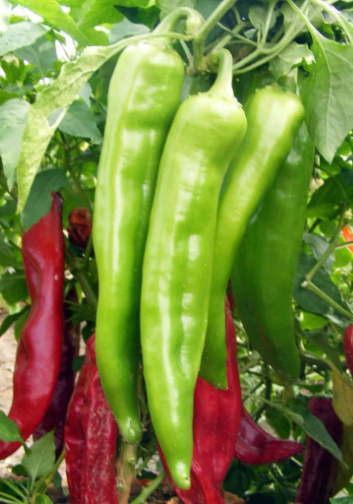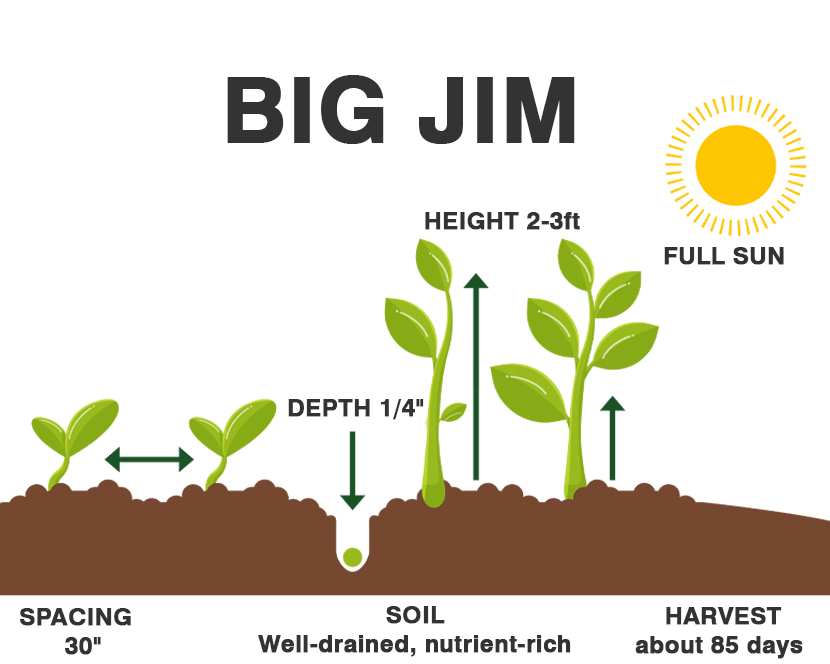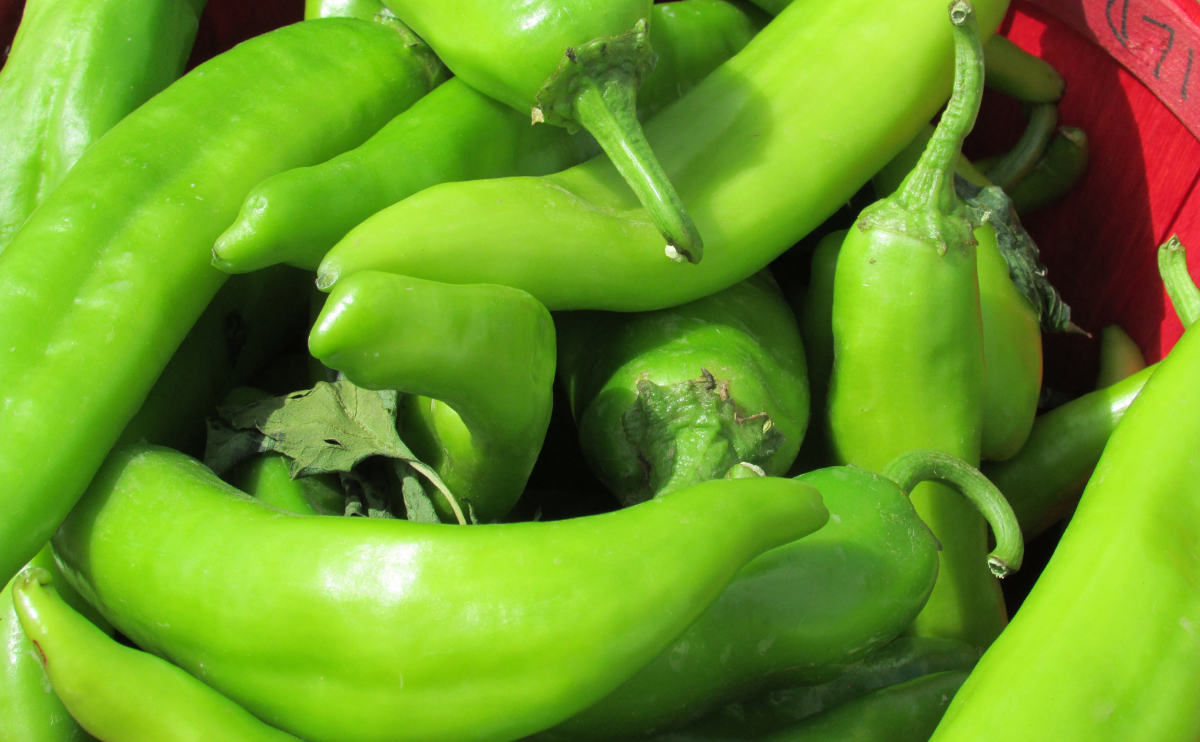The Big Jim pepper is a New Mexico chile pepper cultivar of the species Capsicum annuum with a Scoville rating of mild. This cultivar is extensively grown in New Mexico where it was developed and is popular in New Mexican cuisine. Big Jim peppers are both sweet and mild and are normally picked while still green.

| Common Name | Big Jim pepper |
| Botanical Name | Capsicum annuum |
| Family | Solanaceae |
| Plant Type | Perennial, vegetable |
| Size | 1–4 ft. tall, 1–2 ft. wide |
| Sun Exposure | Full sun |
| Soil Type | Moist, well-drained |
| Soil pH | Acidic, neutral |
| Bloom Time | Summer |
| Hardiness Zones | 9–11 (USDA) |

When to Plant?
This will be determined by your planting zone. There is a final frost date for each area. As a result, you can plan your gardening activities around this date. Check our Frost Dates Across North America: First & Last Frost Dates Chart. However, the date will not be the same for every plant.
How to Plant
Sow seeds 8-10 weeks before planting out after last frost. Plant seeds 1/4 in. deep in well-drained soil in shallow flats. Maintain soil temperature at least 75-85 degrees F for good germination. Peppers won’t germinate in cold potting soil–heat makes a big difference in seeds germinating in 5 days, or seeds taking up to 20 days! (Since germination can be slower if seeds don’t have enough heat, make sure to sow extra seeds in case germination is low.)

Don’t overwater seeds or they may rot. Transplant to 3 in. pots as soon as several leaves have developed. Maintain day temperature 75-80 degrees F, and night temperature at least 65 degrees F. Water plants with warm water. Transplant again to larger pots if the seedlings become too large. Peppers need to have an uncrowded root system or subsequent yields will be reduced. Harden the plants by giving them plenty of light and setting them outside for a few hours on warm days. Be careful not to let the plants wilt. Don’t rush the season: a good rule of thumb is to transfer peppers to the garden after the dogwood blossoms have fallen, or when average soil temperature is 65 degrees F or above (usually a month after last frost).
How to Cultivate
Ideally, water should only be applied to the root zone – an area roughly 6-12” (15-30 cm) from the base of the plant, not the entire plant. A soaker hose is a great investment for keeping plants healthy and reducing water lost through evaporation. Hand watering using a watering wand with a sprinkler head attached is also a good way to control watering. If the garden area is large, and a sprinkler is necessary, try to water in the morning so that plant foliage has time to dry through the day. Moist foliage encourages disease and mold that can weaken or damage plants.
Thoroughly soaking the ground every 2-3 days is better than watering a little daily. Deep watering encourages roots to grow further into the ground, resulting in a sturdier plant with more drought tolerance. How often to water will depend on rainfall, temperature, and how quickly the soil drains.
To check for soil moisture, use your finger or a small trowel to dig in and examine the soil. If the first 2-4” (5-10 cm) of soil is dry, it is time to water.
A well-prepared planting bed enriched with organic matter such as compost or manure and a mild general-purpose, granulated fertilizer gets plants off to a good start. Give plants a boost later in the season with a fertilizer formulated for vegetables.
Fertilizers are available in many forms: granulated, slow-release, liquid feeds, organic or synthetic. Follow the package directions to determine how much, and how typically, to feed.
Be sure to keep the garden well-weeded. Weeds take vital moisture and nutrients away from vegetable plants.
Space plants 18-24 in. apart in rows or blocks. Wait a month to mulch peppers so that the soil can heat up. Small-fruited varieties tolerate hot humid conditions better than large-fruited varieties. Once flowering begins, fertilizer should be withheld; otherwise, flowers may drop without setting fruit. Other factors causing flower drop are low humidity (sometimes caused by wide spacing), poor pollination, full fruit set, or night temperatures above 80 degrees F or below 65 degrees F. In the greenhouse, pollinate peppers the same way tomatoes are pollinated. Maintain high levels of phosphorus for sustained yields. Once fruit production begins, short stakes or small tomato cages may be necessary to prevent large-fruited varieties from falling over.
How to Harvest
Peppers are fully ripe after turning color. Although all peppers may be eaten in the green stage, ripening to red, yellow, etc. increases flavor and nearly doubles the vitamin C content.
Mature plants have good vigor in fall, so cover plants on frosty nights for 1-2 weeks to extend the harvest season. Then, before the first killing frost, uproot plants and place the roots in a bucket of water and store in a cool location to extend harvest by one month, or grow the variety Doe Hill Golden Bell, an excellent keeper. There are several reasons to prune vegetable plants: to help contain a plant’s size, to promote bushy compact growth, to remove dead or diseased stems, and to promote larger, healthier fruit yields.
Flower buds can be pinched off to force the plant energy into fewer fruits that develop faster.
Vining plants can become invasive in a confined garden space. If necessary, entire vines can be removed down to the main stem to keep plants under control.
Never prune away more than 1/3 of the plant, or it may become weak and unproductive.
Remove vegetables as soon as they mature. Leaving them on the plant any longer than necessary can affect flavor and texture, and mature fruit steals energy from younger developing fruits.
Hydroponics
Germination: Start by germinating Big Jim pepper seeds using a seed starter kit or by placing them in a damp paper towel until they sprout. Once the seeds have sprouted, you can transfer them to your hydroponic setup.
pH range: The pH range for Big Jim pepper should be maintained between 5.5 to 6.5.
EC: The EC (Electrical Conductivity) level for Big Jim pepper should be maintained between 1.5-2.5 mS/cm. This level provides enough nutrients for the plant to grow healthily.
PPM: The optimal parts per million (PPM) range for growing Big Jim pepper hydroponically is between 1000 and 1500.
Humidity: The ideal humidity level for growing Big Jim pepper hydroponically is between 40% and 60%. This level will help prevent mold and mildew from forming on the plants.
Light hours: The Big Jim pepper plants require 14-16 hours of light per day during the vegetative stage and 12 hours of light per day during the flowering stage.
Temperature air: The air temperature for Big Jim pepper should be maintained between 70-85°F (21-29°C) during the day and 60-70°F (15-21°C) during the night.
With these guidelines, you should be able to grow healthy plants hydroponically. Good luck, and happy growing!



